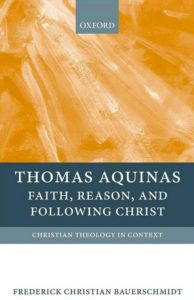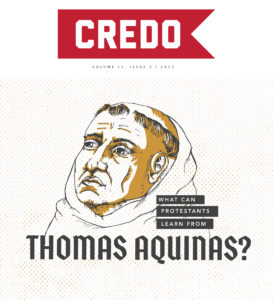 homas Aquinas: Faith, Reason, and Following Christ is a book of this latter kind: it serves as an introduction to Thomas Aquinas and an overview of his work, but it does so by situating him within a context often ignored. Thomas’ theology is, according to this book, “without reserve a theological project oriented to Dominican ends,” and he is “a theologian who is aware in all that he writes of the evangelical purpose of the community of preachers to which he has given his life” (x). Acknowledging that “depending on the background, different aspects of Thomas’ thought stand out more vividly,” Bauerschmidt has tried to show “how Thomas appears when set against the background of the methods and aims of the thirteenth-century Order of Preachers.” The result is
homas Aquinas: Faith, Reason, and Following Christ is a book of this latter kind: it serves as an introduction to Thomas Aquinas and an overview of his work, but it does so by situating him within a context often ignored. Thomas’ theology is, according to this book, “without reserve a theological project oriented to Dominican ends,” and he is “a theologian who is aware in all that he writes of the evangelical purpose of the community of preachers to which he has given his life” (x). Acknowledging that “depending on the background, different aspects of Thomas’ thought stand out more vividly,” Bauerschmidt has tried to show “how Thomas appears when set against the background of the methods and aims of the thirteenth-century Order of Preachers.” The result isa Thomas whose project is more ‘evangelical’ than philosophical –or perhaps philosophical in order to be evangelical—a Thomas for whom Jesus Christ is the one thing necessary, a Thomas who for all his affirmations of the world’s goodness is still a restless wayfarer who yearns for God’s kingdom (315).
If the inevitable thrust of a “theologians in context” approach is to relativize doctrine, then at least in the hands of a Bauerschmidt the doctrine is being rendered relative to the right thing: the spiritual life of the church in service to divine revelation.
Blessed relativizing!
The attempt is successful, the volume is delightful, and the results are fruitful, in particular for putting the evangelical program of the thirteenth century into dialogue with the evangelical program of the twenty-first century. From among many possibilities, I would like to point out the prominent contribution that Bauerschmidt’s presentation of Thomas makes, which is instructive for evangelical theology in particular.
Contemplata aliis tradere: Handing on to others what has been contemplated
It is a commonplace of medieval thought that theology is fides quarens intellectum, faith seeking understanding. But in a luminous section of this book, Bauerschmidt shows how Aquinas complemented this Anselmian insight with another phrase, one which he seems to have coined and which subsequently came to characterize the Dominican vocation: contemplata aliis tradere, or “handing on to others what has been contemplated.” For Thomas, theology is both, but the first is incomplete without the second:
The faith that seeks understanding finds its terminus not in the formulation of more and better theological conclusions, but in the simple act of gazing upon divine truth. In fides quaerens intellectum, one moves form the articles of faith through a discursive process to a deeper contemplative perception of the object of faith. In contemplata aliis tradere one moves from that deepened contemplative perception back through a discursive process of rearticulation of the truth that has been seen, so that others might share in the fruits of one’s contemplative insights (174).
Thomas believed in faith seeking understanding and in handing on to others what has been contemplated. Click To Tweet Bauerschmidt uses this spiritual and vocational key to unlock some of the puzzles of Thomas’ career path. Why was he in and out of university posts, serving two separate times in Paris as magister? Why did he return insistently to his vocation as a Dominican friar, such that “Paris and its university… were merely episodes in Thomas’ life,” while the network of Dominican schools in Naples, Viterbo, and Rome were his “natural habitat?” (ix) Why not become a secular master rather than a preaching friar? Why not take the tenured job and the opportunity to write more systematically in the exposition of Aristotle?
Bauerschmidt insists on “the obvious answer,” which is that “Thomas became a Dominican” because he “wanted to do what Dominicans were in fact founded to do: to preach the Gospel of Jesus Christ and to care for souls, primarily through hearing confessions.”Thomas wanted to preach the Gospel of Jesus Christ and to care for souls. -Bauerschmidt Click To Tweet
Thomas became a Dominican because he recognized with St. Dominic that, as Jean-Pierre Torrell puts it, ‘to announce what one has understood of the Gospel truth to someone deprived of it is to come to the aid of the worst poverty and to participate in the highest act of divine mercy.” (175, citing Torrell 381-2)
Thomas had a staggering desire to understand the truth, of course. But equally strong was his desire to hand on to others what he had come to learn. In the passage of the Summa where Thomas coins the phrase contemplata aliis tradere, he has been discussing why the contemplative life is superior to the active life. But he presses on to say that the highest life is the one that moves beyond contemplation to the teaching of the fruits of contemplation. “Faith seeks understanding not simply for its own edification, but in order to communicate the mysteries of faith in a way that conforms to the exigencies of rational animals” (175).
At least two characteristics seem to be connected to the way Thomas conceives of the spiritual vocation of teaching, and both of them would be medicinal for contemporary theology, not least evangelical theology. First, there is a self-effacing character to this contemplata aliis tradere, emphasizing the things contemplated, the fruits of the encounter with them, rather than the personal characteristics of the theologian doing the contemplating or the passing along. Many writers on Thomas have said that he “doesn’t really have a personal style; you have the feeling that for him nothing he writes is his.” In his recent life of Thomas, Denys Turner traced this refusal “to be scintillating” or to draw attention to himself to his Dominican vocation:
Everyone loves to quote the Thomas who says that it is better to cast light for others than merely to shine for oneself, and truly the Dominican motto, contemplata aliis tradere, the passing on to others what one has encountered in contemplation, is nearly as good as it gets as a précis of Thomas’s holiness.
It may be mind-boggling to think of the Summa Theologiae as a handbook designed to enable a vigorous preaching ministry, but such it is. Click To Tweet Second, handing on the fruits of contemplation is an approach that keeps just the right amount of appropriate activism in the theological life, yoking our research and teaching directly to at least one of the spiritual works of mercy. Thomas the Dominican, or Thomas according to Bauerschmidt, exemplified this practical or active thrust for theology. It may be mind-boggling to think of the Summa Theologiae as a handbook designed to enable a vigorous preaching ministry, but such it is. If academic theology needs to learn to pay attention to the lives and needs of pastors and ministers of the word at the congregational level, which it can learn by taking on a little of the mendicant’s mindset, it also needs to learn from the astonishing attention span exhibited by the great Dominican teacher of preachers.
The churches of the Reformation have sometimes defined themselves over against the Roman Catholic church as confessing churches, churches that stand before God and are summoned to speak the truth to him and then about him, in distinction from the Roman magisterial stance of ecclesia docens, the authoritative church that hands down teaching to the people. There is a contrast of posture even when the substance of the doctrines is the same: Reformation churches look up to God and speak openly before his face, while the Roman church looks down responsibly to those who it is charged with teaching.
Evangelicals have much to learn from Thomas about the vocation of the theologian
Whatever gestural indication of the truth this contrast may evoke, it is an overdrawn contrast and has fallen out of fashion as “comparative symbolics” has declined. I only bring it up to indicate the way Roman Catholic and Protestant evangelical theologians may differ in their application of “handing on the fruits of meditation.” Protestant evangelicals have much to learn from Thomas about this vocation of the theologian. When we have learned this well and truly appropriated it, no doubt it will take on the Protestant inflection, and perhaps will be manifest in our theology as “passing on the fruit of confession.”
The first helpful theological tool I found in Bauerschmidt’s version of Thomas Aquinas was an approach to teaching summed up in the motto contemplata aliis tradere. The second thing, even more helpful and of even broader application for contemporary theological work, is the scope and clarity Bauerschmidt gives to the category of fittingness, or convenientia. If the caricature of Thomas is that he is primarily a philosopher, mainly an Aristotelian, principally a metaphysician, then categories like necessity will come to the foreground. Indeed, in various waves of interest in Thomas, from the generation of Suarez and Cajetan to now, great emphasis has been laid on necessity, and on Thomas’ development of nascent rules for analogical predication. Bauerschmidt shifts the emphasis to covenientia, which he points out is “important in Thomas’ theology, particularly when dealing with the events of salvation history” (161).
Bauerschmidt points out that fittingness “offers a form of reasoning that is in a way suppler than that of the syllogistic demonstration and which reveal what might be called an ‘aesthetic’ dimension to Thomas’ theology” (161). What he has in mind shows up especially in the series of articles on events in the life of Jesus: why did the messiah come so late in salvation history, but not at the very end? Why did he die a violent death? Why the virgin birth? Etc. There was a long tradition of raising these questions and answering them with elaborations of how eminently fitting it was that God should do what he in fact did. Athanasius’ On the Incarnation proceeded thus, and so did Anselm’s Cur Deus Homo. Thomas takes up this traditional tool of convenientia and hones it considerably. “Arguments ex convenientia are a way of displaying the ‘necessity’ of the events of salvation history,” Bauerschmidt explains, but he has scare quotes around “necessity” and he quickly makes a distinction in different meanings of the word.
Unless there is some kind of necessity in our understanding of the economy of salvation, we are only putting forth opinio rather than scientia: It is the character of scientia to give reasons for what is asserted. But in the economy of salvation we are dealing with the free acts of the living God, and these are not subject to strict necessity. “Thomas readily admits that the economy of salvation could have been ordered differently –e.g. it could have not included the incarnation or Christ’s death on the cross” (141). As a result, there can be no argument from necessity for such events.
But arguments ex convenientia are quite appropriate in this sphere: insight “is not arrived at by the discursive progress of the syllogism, but by the holistic insight in which we see the ‘rightness’ of salvation history” (161). Syllogistic argument from necessity lets us see the binding connections between two things, like using geometric argument to see the implications of axioms. But argument ex convenientia lets us see how the thing itself holds together, analogous to seeing how a piece of architecture works.
These arguments ex convenientia have wide application throughout Thomas’ work, and Bauerschmidt has an especially helpful section explaining how they shape Thomas’ presentation of the doctrine of the Trinity, which turns on whether “procession” is the kind of thing it is fitting, conveniens, to ascribe to God. But arguments ex convenientia come into their own in telling the reasons for the gospel story. Human reasoning, according to Thomas, is “utterly incapable of demonstrating the truth of the mysteries of faith, such as the incarnation or salvation through the cross of Christ” (162).
I find Bauerschmidt’s account of fittingness in Thomas’ thought to be highly suggestive. It is the kind of motif that needs only to be pointed out and named in order to be thereafter observable all throughout the field of theology. In the locus of trinitarian theology alone, to which Thomas gave massive attention and to which Bauerschmidt also gives much, arguments ex convenientia enable theology to navigate a number of narrows and rapids that have sunk lesser crafts in recent decades. Much of the confusion generated by the Rahnerian style of radically economic trinitarianism could have been much better handled if the role of fittingness arguments had been recognized and respected.
With such a framework in place, may we not have bypassed the problematic, strong necessitarian arguments of “Rahner’s Rule,” and said instead that the economic Trinity fits the immanent Trinity?
*This review was adapted from a paper Dr. Sanders read at ETS 2013 in Baltimore, as part of a panel responding to “Hillbilly Thomist” Fritz Bauerschmidt’s book on Thomas Aquinas and was originally published on his blog, Scriptorium Daily.


